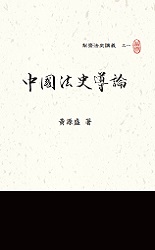Only available in Chinese.
本書係中國法史教課講義,採取「輕其所輕、重其所重」的書寫方式,有選擇性的集中講述其中幾個核心課題。
自先秦以迄民國,以「歷史時期」區分為經;從法律規範、法律制度到法律思想、司法實踐乃至法律意識,以「問題導向」解析為緯,兼採「變」與「不變」的靜態與動態觀察法,期能既通達也能扼要,俾讀者展卷瞭然,尤盼有助於提升年輕學子的人文素養。

The Introduction of the legal History of China |
|
| Author: | Huang, Yuan Sheng |
| Press: | Plow Club |
| Publication Date: | 2016/02/01 |
| Language: | Traditional Chinese |
Only available in Chinese.
本書係中國法史教課講義,採取「輕其所輕、重其所重」的書寫方式,有選擇性的集中講述其中幾個核心課題。
自先秦以迄民國,以「歷史時期」區分為經;從法律規範、法律制度到法律思想、司法實踐乃至法律意識,以「問題導向」解析為緯,兼採「變」與「不變」的靜態與動態觀察法,期能既通達也能扼要,俾讀者展卷瞭然,尤盼有助於提升年輕學子的人文素養。
Contents
Introduction:
The First Lesson of Legal History Science 1
I. Defining “Legal History Science” 5
II. Research Subjects and Scope of Legal History 14
III. Research Purposes and methodologies of Chinese Legal History 23
Pandect:
Pursuing the Remote Past 41
Chapter One: The Origins of Norms and Formation of Legal Systems 43
I. The Origins and Developments of Social Norms 44
II. The Customs and Customary Law in Traditional Chinese Society 57
III. The Roman and Chinese Legal Systems in History 64
Chapter Two: The Contents and Features of Traditional Chinese Legal Culture 77
I. The Legal Theory on the Instinctive Connection between People
and Nature 78
II. The Mixed Legal Compilation Based on Criminal Punishment 84
III. Legal Ideas Based on Family Ethics 92
IV. The Combination and Separation of Judicial and Executive
Powers 101
V. Law and the Reality 109
Early Ancient Period:
Prototype of Classic Chinese Legal Culture 121
Chapter Three: Chinese Feudal Society and Legal Philosophies in Pre-Qin Period 123
I. The Feudal System and Legal Ideas of Western Zhou 123
II. Legal Theories of Pre-Qin Philosophers 130
III. The Promulgated Controversy of Late Chuen Qiou 153
IV. The Origin of Chinese Systematic Codified Laws 163
Chapter Four: Norms of Qin-Han and the Criminal Judgments in Lian
Han Chuen Qiou 171
I. Shuihudi Bamboo Text and Qin Code 171
II. The Legal Norms and Practice of Early Han 176
III. Zhangjiashan Bamboo Text and the Legal Norms of Early Han 186
IV. The Criminal Judgments in Chuen Qiou and under Confucianism 191
Middle Ancient Period:
The Maturity and Succession of Codified Laws 223
Chapter Five: The Thinking of Manners and Punishment in the Tang Code 225
I. Predecessors and Achievements of the Tang Code 226
II. The Legislative Theoretical Basis of the Tang Code 235
III. The Principle of “Morals as a Basis for the Application of Practical” in the Tang Code 241
IV. Review on “Morals as a Basis for the Applications of Penalties”
in the Tang Code 253
Chapter Six: The Legal Culture of Song and Yuan 265
I. Legislature and Judiciary of Song 266
II. The Variability and Invariability of Song Norms 272
III. Judicial Exams and Judicial Judgments of Song 277
IV. The Variability and Features of Yuan Norms 283
V. The Criminal System and Judiciary Institutions of Yuan 292
Early Modern Period:
The Reorganization and Transformation of Chinese Legal Culture 297
Chapter Seven: The Legal Development of Ming and Ching 299
I. The Content and Features of Ming Code 300
II. Judiciary of Ming 305
III. Legislature of Ching 310
IV. Judiciary of Ching 319
Late Modern Period:
Impact of the West and Evolution of the Laws 331
Chapter Eight: The Social Transformation and Legal Modernization
during the Late Ching Period 333
I. From Native Law to Received Law 334
II. Complementary Measures during the Process of Legal Westernization 348
III. Controversies during Late Ching Legal Transformation 365
IV. Key Points to the Turning Point of Late Ching Legal Transformation 393
V. The Historical and Time Meaning of Late Ching Legal Reception of Foreign Laws 406
Chapter Nine: Inheritance and Innovation of the Republic Norms 415
I. Transitional Norms of Beiyang Government 416
II. The Enactment of the Six Codes of Nationalist Government in Nanjing 433
III. The Drift of the Six Codes to Taiwan 444
IV. Reflections on the Centurial Republican Legal Culture 454
Conclusion 469
Appendixes 475
I. Chronology of Imperial Legal Culture 477
II. Chronology of Legal Events during the Late Ching and the Early Republic 489
III. Index 501